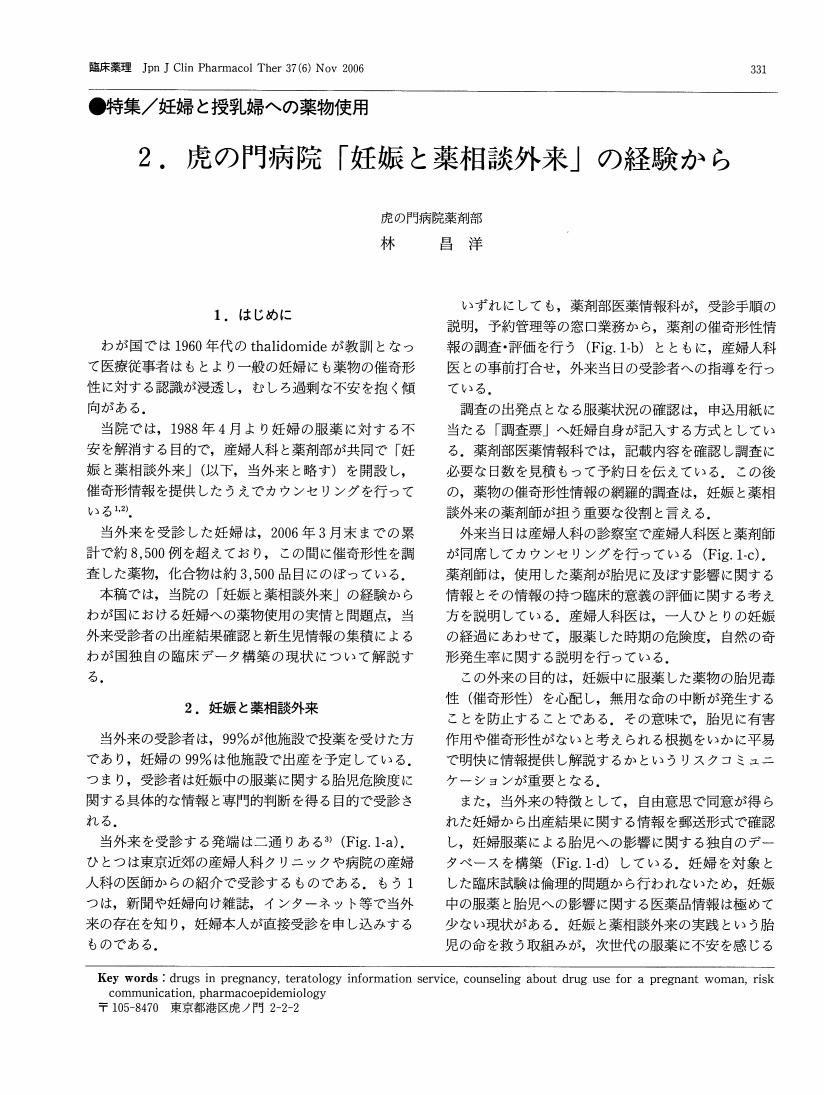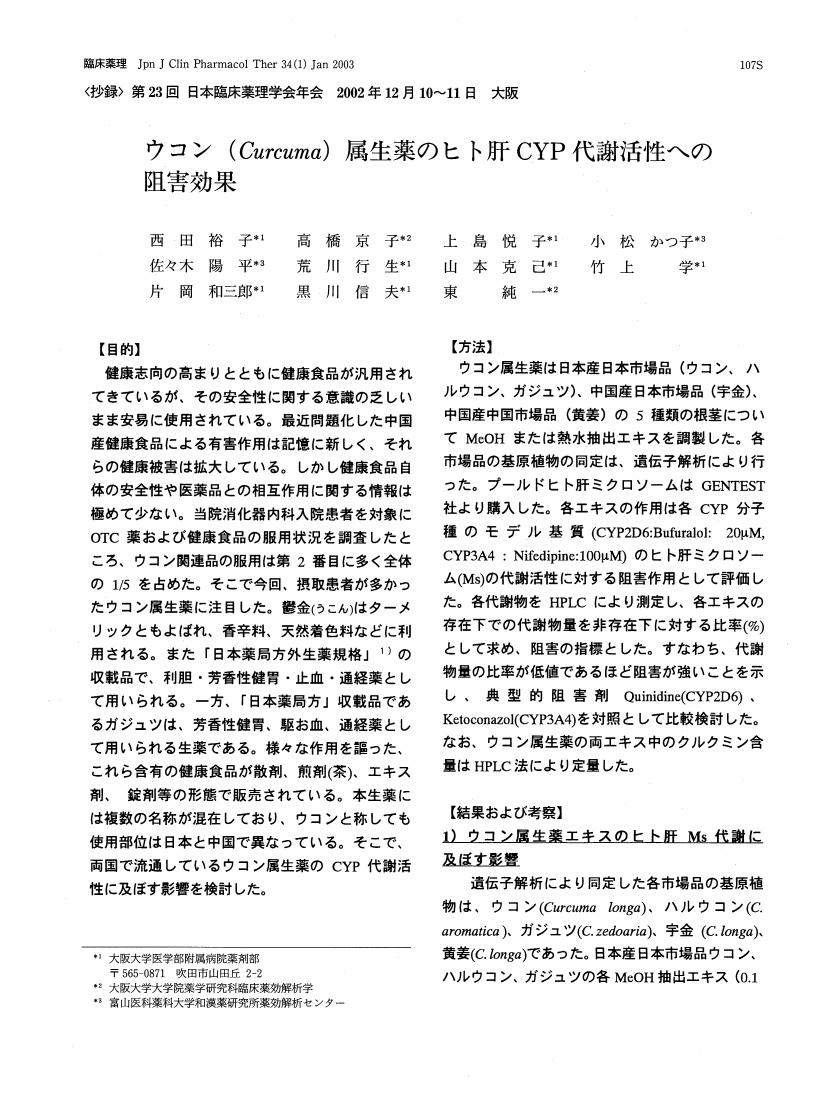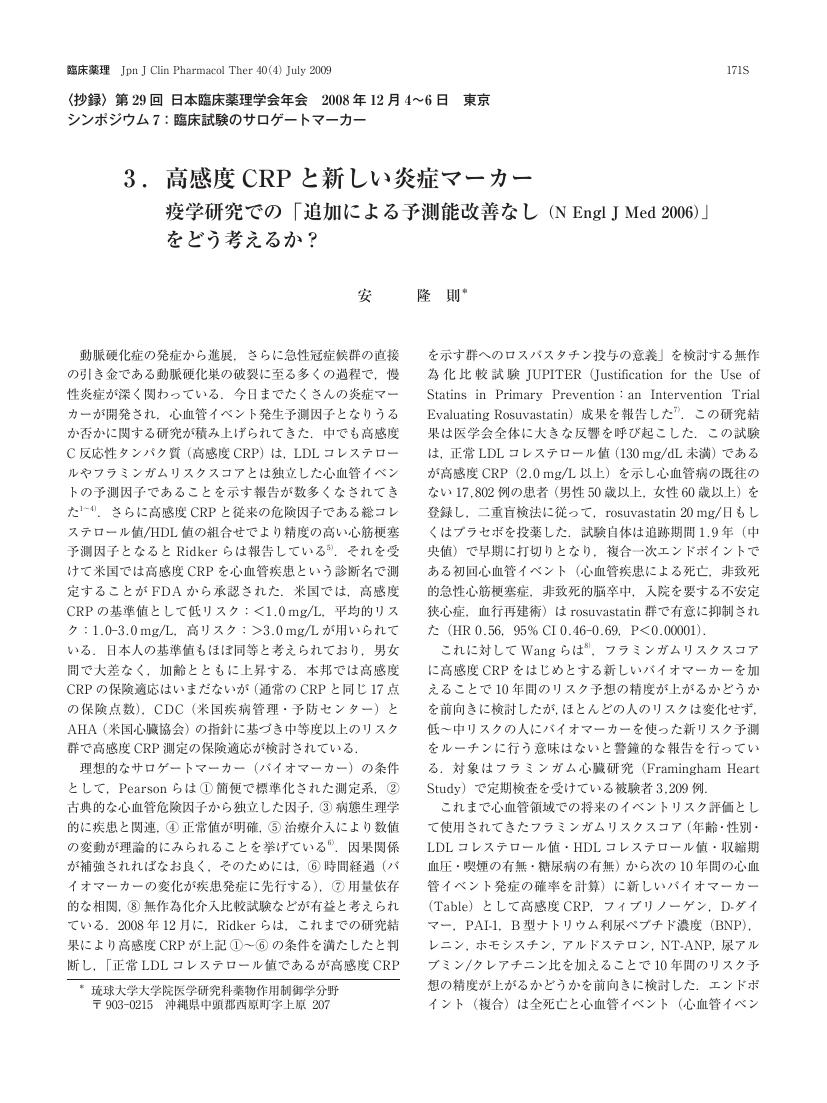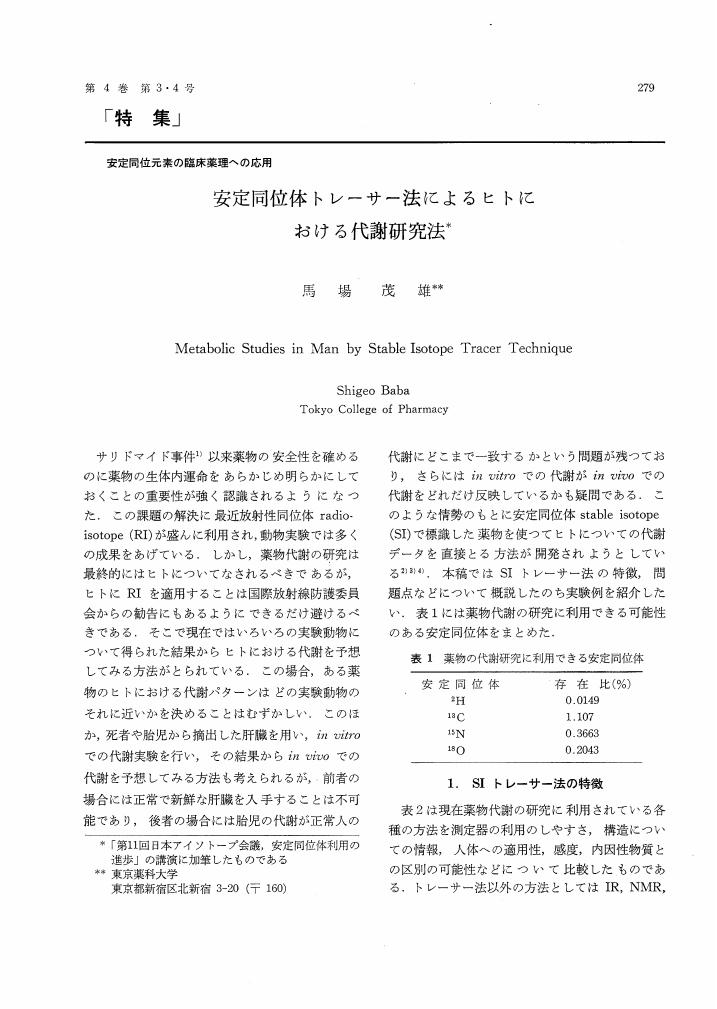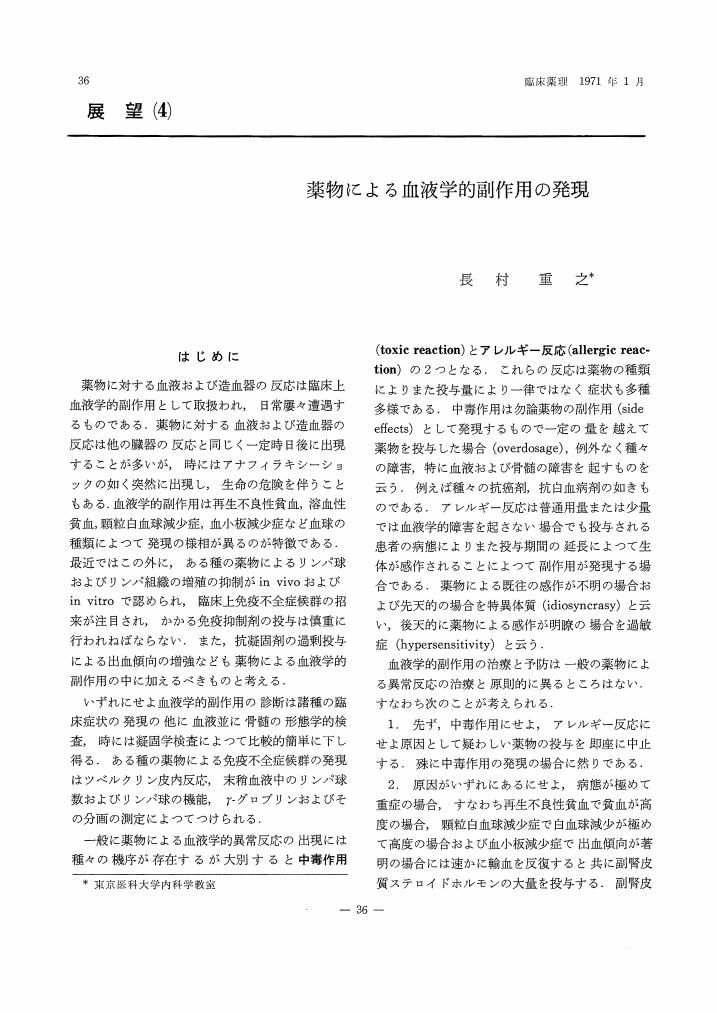1 0 0 0 OA ヒト肝ミクロソームおよび遺伝子組換えヒトCYP発現系によるエトポシドの代謝
- 著者
- 河城 孝史 山下 幸和 Xue-Jun Zhao 小山 恵理子 谷 昌尚 千葉 寛 石崎 高志
- 出版者
- 一般社団法人 日本臨床薬理学会
- 雑誌
- 臨床薬理 (ISSN:03881601)
- 巻号頁・発行日
- vol.28, no.1, pp.175-176, 1997-03-31 (Released:2010-06-28)
- 参考文献数
- 3
1 0 0 0 OA 2. 虎の門病院「妊娠と薬相談外来」の経験から
- 著者
- 林 昌洋
- 出版者
- 一般社団法人 日本臨床薬理学会
- 雑誌
- 臨床薬理 (ISSN:03881601)
- 巻号頁・発行日
- vol.37, no.6, pp.331-337, 2006-11-30 (Released:2010-06-28)
- 参考文献数
- 3
1 0 0 0 OA Suxibuzoneの生体内動態(第5報)
- 著者
- 景山 孝正 大野 文俊 安田 行寛 新藤 恭司 三谷 鳴夫 丸伝 章 赤沢 明
- 出版者
- The Japanese Society of Clinical Pharmacology and Therapeutics
- 雑誌
- 臨床薬理 (ISSN:03881601)
- 巻号頁・発行日
- vol.10, no.4, pp.525-533, 1979-12-30 (Released:2010-06-28)
- 参考文献数
- 9
- 被引用文献数
- 1 1
The biological fate of suxibuzone (SB), a new non-steroidal anti-inflammatory agent, was studied in healthy male volunteers with single oral doses and compared with that of phenylbutazone (PB) by a cross-over test, with the following results:1) PB, oxyphenbutazone (Oxy-PB), and γ-hydroxy-phenylbutazone (γ-Hydroxy-PB) were identified in plasma after oral administration of SB. Moreover these metabolites, their glucuronides, SB-glucuronide, 4-hydroxymethyl-phenylbutazone (4-HM-PB)-glucuronide, and p, γ-dihydroxy-phenylbutazone (p, γ-DH-PB) were found in urine.2) Peak plasma concentration of the metabolites was obtained 4 hrs after a single oral dose of 426 mg of SB when the concentration of PB, the main metaboliteof SB, was 36μg/ml, much the same as the corresponding level in the volunteers receiving PB. On the other hand, there was no difference between volunteers receiving SB and PB interms of the concentration of Oxy-PB. But the concentration of γ-Hydroxy-PB was higher after oral SB than after oral PB.3) Urinary excretion of the metabolites was about 8% of the administered dose up to 16 8hrs after oral doses of SB or PB, but in the period shortly after oral doses of SB, Oxy-PB-glucuronide and γ-Hydroxy-PB were excreted to ag reater extent than after oral doses of PB.4) From these results in the plasma and urine after oral doses of SB, it was found that SB may be characterized as a prodrug of PB.5) During the experiment, no side effects or abnormalities were observed in the medical examination and laboratory test except for a slight decrease in the uric acid level in plasma.
1 0 0 0 OA ウコン (Curcuma) 属生薬のヒト肝CYP代謝活性への阻害効果
1 0 0 0 OA CHDF施行患者におけるミカファンギン体内動態に関する検討
1 0 0 0 フレカイニド内服中に心停止をきたした高齢担癌患者の1例
- 著者
- 小西 寿子 志賀 剛 瀬下 明良 木村 利美
- 出版者
- 一般社団法人 日本臨床薬理学会
- 雑誌
- 臨床薬理 (ISSN:03881601)
- 巻号頁・発行日
- vol.49, no.4, pp.169-172, 2018-07-31 (Released:2018-08-22)
- 参考文献数
- 8
- 被引用文献数
- 1
症例は83 歳,男性.経皮的冠動脈形成術後に伴う心室期外収縮に対してフレカイニド 50 mg 1回 1錠 1日 2 回で服用していた.中部胆管癌を併発し,食事摂取量が減り,体重も減少した.他院でビタミン C 大量静注中に心肺停止を来し,心肺蘇生により心拍再開を得た.当院救急搬送後,心電図にてQT 間隔の延長 (0.76秒) を認め,フレカイニドを中止した (血中フレカイニド濃度は治療域であった) .さらに血清カリウム値が 2.0 mEq/L,血清アルブミン値が 2.7 g/dL と低値であったため,カリウム製剤による補正を行うとともにヒト血清アルブミン製剤 25 g/日の投与と中心静脈栄養を併用することで血清カリウム値も改善し QT 間隔が正常化した.本例では食事摂取不良による低栄養から低カリウム血症を来し,フレカイニドによる QT 延長作用が増強し心停止に至ったと考えられた.
- 著者
- 安 隆則
- 出版者
- 一般社団法人 日本臨床薬理学会
- 雑誌
- 臨床薬理 (ISSN:03881601)
- 巻号頁・発行日
- vol.40, no.4, pp.171S-172S, 2009 (Released:2009-10-15)
- 参考文献数
- 10
1 0 0 0 OA 慢性気道炎症とマクロライドの新作用
- 著者
- 工藤 翔二
- 出版者
- 一般社団法人 日本臨床薬理学会
- 雑誌
- 臨床薬理 (ISSN:03881601)
- 巻号頁・発行日
- vol.29, no.3, pp.539-540, 1998-05-31 (Released:2010-06-28)
- 参考文献数
- 4
1 0 0 0 OA 3.WarfarinとCYP2C9,VKORC1遺伝子多型
- 著者
- 高橋 晴美
- 出版者
- 一般社団法人 日本臨床薬理学会
- 雑誌
- 臨床薬理 (ISSN:03881601)
- 巻号頁・発行日
- vol.39, no.6, pp.243-246, 2008 (Released:2009-03-01)
- 参考文献数
- 11
Warfarin is the mainstay of anticoagulation therapy, worldwide. Its clinical use, however, is complicated by the fact that it has a narrow therapeutic index with potential bleeding complications. The dosage requirement of warfarin to produce therapeutic anticoagulation varies widely among patients. Recently genetic factors such as the CYP2C9 and VKORC1 genes have been demonstrated to be determinants of warfarin response. CYP2C9 is the enzyme primarily responsible for the metabolic clearance of the S-enantiomer of warfarin. VKOR is the target protein of warfarin which recycles the reduced form of vitamin K, an essential cofactor in the formation of the vitamin K-dependent clotting factors. There is strong evidence to support an association between these genetic variants and therapeutic doses of warfarin. On the basis of these observations, the Food and Drug Administration (FDA) approved a labeling change for warfarin that includes the genetic information of VKORC1 and CYP2C9 as factors influencing inter-individual variability in warfarin dosing. The package insert as of August 2007 states that “lower initiation doses should be considered for patients with certain genetic variations in CYP2C9 and VKORC1 enzymes.” The FDA also approved clinical tests for these genetic variants. However, at present, a validated dosing algorithm, evidence of the clinical utility of genotyping and a reliable economic analysis are not availabie to recommend routine CYP2C9 and VKORC1 testing in every patient before the initiation of warfarin. The results of several randomized prospective controlled trials conducted to test the impact of genotype-guided warfarin dosing in Caucasian and Asian patients are shown in this review.
1 0 0 0 5.日本人小腸におけるチトクロームP450(CYP)分子種の発現
- 著者
- HASHIGUCHI Masayuki WATANABE Eriko CHIYODA Takeshi IRIE Shin KUROKAWA Tatsuo MOCHIZUKI Mayumi
- 出版者
- The Japanese Society of Clinical Pharmacology and Therapeutics
- 雑誌
- 臨床薬理 (ISSN:03881601)
- 巻号頁・発行日
- vol.44, no.1, pp.29-36, 2013
- 被引用文献数
- 1
<b>Background:</b> Lifestyle-related diseases are increasing in Japan, and the national medical expenditure is increasing. Converting prescription drugs to over-the-ounter (OTC) drugs would appear to be one solution to cut expenditure. The willingness to pay (WTP) of the Japanese public for OTC imidapril, an angiotensin-converting enzyme (ACE) inhibitor, as a healthcare-related item has not been evaluated.<br><b>Objective:</b> To measure the value of OTC imidapril as a health care-related item by investigating the public's WTP as self-medication for primary prevention of stroke, assuming that ACE inhibitors are switched from prescription-only to OTC status.<br><b>Methods:</b> A questionnaire was distributed among healthy individuals engaged in various jobs in office buildings (including a clinic) in Tokyo and Fukuoka, Japan. For the WTP question format, the double-bound dichotomous choice approach was employed. Participants were randomly assigned to 3 groups. Group A was provided with a starting price per month of ¥6,000, group B with ¥8,000, and group C with ¥10,000. Weibull regression analysis was used to investigate factors affecting WTP.<br><b>Results:</b> The questionnaire survey was completed correctly by 311 individuals (156 men, mean age 50 years), and the mean WTP was ¥7,237 per month. Weibull regression analysis showed that gender significantly affected WTP. The bid acceptance rates differed among the age groups of 20-39 years, 40-64 years, and ≥65 years.<br><b>Conclusion:</b> The public's WTP amount was approximately ¥7,000 per month, and the WTP based on the questionnaire responses was about 20% lower than the present cost for physician visits. (Jpn J Clin Pharmacol Ther 2013; 44(1): 29-36)
1 0 0 0 OA FD-1の活性化と生体内動態に関する実験的および臨床的知見
- 著者
- 竹内 和彦 渡辺 裕司 Tran Quan-Kim 楊 軍 小菅 和仁 寺田 肇 大橋 京一
- 出版者
- 一般社団法人 日本臨床薬理学会
- 雑誌
- 臨床薬理 (ISSN:03881601)
- 巻号頁・発行日
- vol.32, no.1, pp.27S-28S, 2001-01-31 (Released:2010-06-28)
1 0 0 0 OA 安定同位体トレーサー法によるヒトにおける代謝研究法
- 著者
- 馬場 茂雄
- 出版者
- The Japanese Society of Clinical Pharmacology and Therapeutics
- 雑誌
- 臨床薬理 (ISSN:03881601)
- 巻号頁・発行日
- vol.4, no.3-4, pp.279-287, 1973-12-30 (Released:2010-06-28)
- 参考文献数
- 21
1 0 0 0 OA 1.抗血小板薬とその作用機序
- 著者
- 西川 政勝 田丸 智巳
- 出版者
- 一般社団法人 日本臨床薬理学会
- 雑誌
- 臨床薬理 (ISSN:03881601)
- 巻号頁・発行日
- vol.40, no.6, pp.253-260, 2009 (Released:2009-12-25)
- 参考文献数
- 28
- 被引用文献数
- 1 1
Antiplatelet drugs belong to the class of pharmaceuticals that inhibit platelet activation and thereby suppress arterial thrombus formation. They are widely used for primary and secondary prevention of atherothrombotic diseases including coronary heart diseases, ischemic strokes and peripheral arterial diseases. These drugs are broadly classified into two categories: (1) inhibitors of the platelet activation signal-transduction system, and (2) stimulators of production of inhibitory signals such as cAMP and cGMP. The first category comprises ADP receptor (P2Y12) antagonists including ticlopidine, clopidogrel and prasugrel; the serotonin 5-HT2 receptor antagonist sarpogrelate; the cyclooxygenase-1 inhibitor aspirin; and eicosapentaenoic acid. The second category comprises prostacyclin analog, the cyclic nucleotide phosphodiesterase (PDE)-3 inhibitor cilostazol, and the PDE-5 inhibitor dipyridamole. Drugs in the second category stimulate vasodilation, as well as inhibit platelet aggregation. Current clinical trial evidence favors the use of aspirin, clopidogrel and cilostazol as first-line agents in the majority of patients with vascular disease. Clinical trials evaluating novel antiplatelet drugs will impact the direction of future practice.
1 0 0 0 OA 薬物による血液学的副作用の発現
- 著者
- 長村 重之
- 出版者
- 一般社団法人 日本臨床薬理学会
- 雑誌
- 臨床薬理 (ISSN:03881601)
- 巻号頁・発行日
- vol.2, no.1, pp.36-40, 1971-01-30 (Released:2010-06-28)
- 参考文献数
- 12
1 0 0 0 OA 座長のまとめ
- 著者
- 梅村 和夫 和田 孝一郎
- 出版者
- 一般社団法人 日本臨床薬理学会
- 雑誌
- 臨床薬理 (ISSN:03881601)
- 巻号頁・発行日
- vol.42, no.2, pp.63-64, 2011 (Released:2011-06-30)
1 0 0 0 OA 4.TGN1412事件の倫理的問題点:薬事規制による被験者保護の限界
- 著者
- 栗原 千絵子
- 出版者
- 一般社団法人 日本臨床薬理学会
- 雑誌
- 臨床薬理 (ISSN:03881601)
- 巻号頁・発行日
- vol.39, no.4, pp.113S-114S, 2008 (Released:2009-02-04)
- 参考文献数
- 8
1 0 0 0 OA 累積二項確率の能率的算出法
- 著者
- 栗谷 典量
- 出版者
- 一般社団法人 日本臨床薬理学会
- 雑誌
- 臨床薬理 (ISSN:03881601)
- 巻号頁・発行日
- vol.10, no.1, pp.69-70, 1979-03-30 (Released:2010-06-28)

